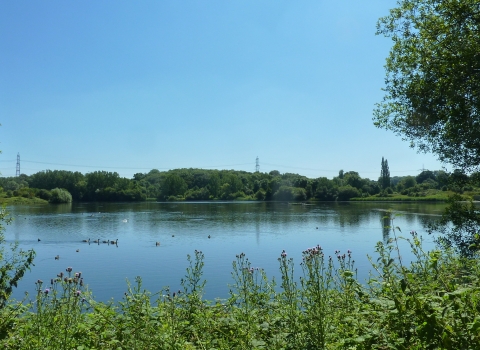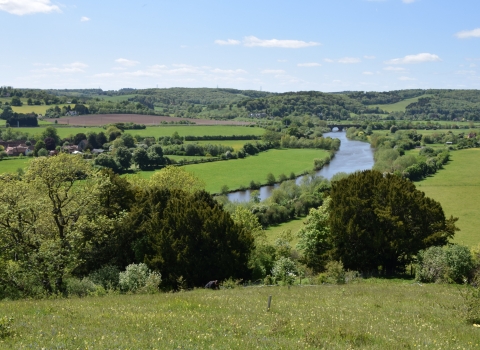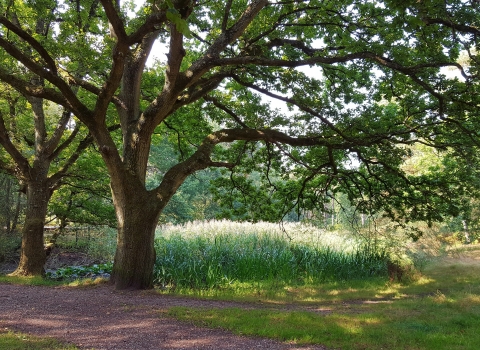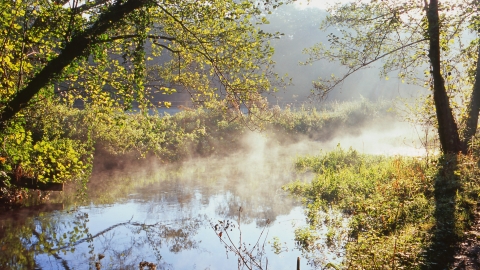
Clive Ormonde
Location
Know before you go
Dogs
When to visit
Opening times
Open at all timesBest time to visit
All year roundAbout the reserve
A place of great character
Large swathes of tranquil woodland surround a patchwork of meadows and pastures set in the heart of the Pang Valley in Berkshire. The River Pang meanders through the woodland providing a beautiful setting that is thought to have inspired E. H. Shepard to illustrate The Wind in the Willows by Kenneth Grahame.
An Aladdin's Cave
The four areas of woods are floodplain woodlands that provide homes to many species that love moist ground, such as alder trees and clusters of yellow iris. Plentiful supplies of rotting wood lying in the damp attract a range of fungi, beetles and other insects.
Seasonal highlights
Moor Copse is a wonderful reserve to visit all year round. In spring, woodland flowers and meadow flowers provide a colourful carpet whilst birds sing their hearts out.
In summer, butterflies are abundant, including the handsome silver-washed fritillary whose larvae feed on violets. Dragonflies and damselflies, such as the beautiful demoiselle and the brown hawker hunt up and down the river.
In autumn, the woodlands provide vibrant colour as the leaves gradually turn, and a diverse range of fungi, including deadman's fingers and green elfcup, push up from the leaf litter, or appear on dead wood.
As winter creeps in you may see a fox or stoat as they work hard to survive. Walks by the Pang and through the meadows are truly memorable when the landscape is encrusted with a sparkling winter frost.
Creating new grassland
In December 2006, with generous support from its members, BBOWT was able to purchase land adjoining Moor Copse, which doubled the size of the reserve. Supported by an active volunteer group, the Trust is restoring the area for wildlife.
The extension contained a field which the Trust has been transforming into a flower-rich grassland. Thousands of trees have been planted to link the existing woodland areas. Other areas will be left or lightly grazed to form tussocky patches which attract small mammals such as mice and voles, which in turn provide vital food for predators such as the barn owl.
Encouraging water voles
Recently cleared trees from a stretch of Sulham Brook will encourage the nearby water vole population to colonise this part of the stream. The much-loved water vole is Britain's most endangered mammal because of predation by non-native mink.
Coronation Meadows
Moor Copse is one BBOWT’s most charismatic wildflower meadows which have been named Coronation Meadows. King Charles III, as patron of RSWT, Rare Breeds Survival Trust and Plantlife, initiated the Coronation Meadows project in 2012/13. It celebrates the historic and extraordinary diversity of meadows, and encourages the creation of many more in the next 60 years through seeds and green hay from the Coronation sites.
Coronation Meadows represent a certain ethos; an attitude towards farming, rearing livestock and an appreciation of the value of farmland wildlife that has allowed these fragments of flower rich grassland to survive over the decades.
The BBOWT reserves Chimney Meadows, Moor Copse and Upper Ray Meadows are prime examples of a Coronation Meadow because they are rich in a wealth of wild flowers. On each reserve there are meadows which have been regenerated using green hay from nearby land, a natural spread of species from field to field. The meadows are managed carefully using traditional farming methods, sometimes with rare breed livestock for conservation grazing. Ancient hedgerows and tracks connect each meadow to the next these are just as important for wildlife as the meadows themselves. They help to create patchworks of habitats greater than their individual parts. Coronation Meadows is supported by Biffa Award.
|
Ash dieback A large number of ash trees at Moor Copse are showing extensive signs of ash dieback and may become increasingly unstable. Work by specialist contractors is focused on removing trees which are a hazard to the public, such as along paths and roads. To minimise the number of trees we need to remove and to ensure the safety of visitors, some paths will be closed temporarily and others permanently. There will be signs on site to help you. Please stick to the waymarked routes and avoid areas where work is taking place. The work is being timed to minimise the impact on wildlife. Trees have been surveyed and where possible important bird and bat habitat will be retained. To find out more, read our ash dieback FAQs |
Reserve champions - supporting their favourite reserve
Rachel Paton: "In memory of my mother Ann, a long standing BBOWT member."
David Smith: "Thank you BBOWT for your invaluable work at the Moor Copse Reserve."
Things to do
- Try our circular Wildlife Walk (1 mile). Just follow the badger waymarkers.
- Look out for our seasonal guided walks.
- Visit the Moor Copse website, which our volunteer warden keeps up to date with recent wildlife sightings and activity on the reserve.
Species
- Primrose
- wood anemone
- Wood spurge
- Wild cherry
- Cuckooflower
- Bugle
- Early purple orchid
- Bluebell
- Yellow iris
- Purple-loosestrife
- Honeysuckle
- Spindle
- Marsh tit
- Kingfisher
- Raven
- Song thrush
- Tawny owl
- Great spotted woodpecker
- Sparrowhawk
- Skylark
- Meadow pipit
- Grass snake
- Brimstone
- Orange-tip
- Speckled wood
- Silver-washed fritillary
- Banded demoiselle
- Brown hawker
- Red fox
- European badger
Contact us
Environmental designation
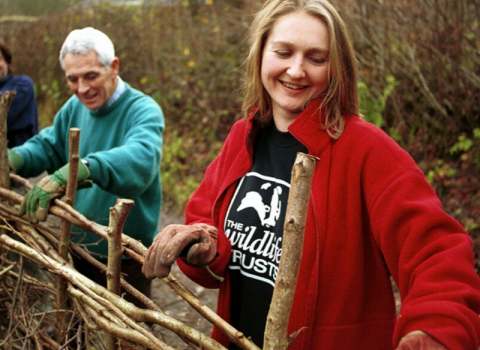
Volunteer with us
Our volunteers help us in so many ways - by working on nature reserves, helping at visitor centres, leading walks, training others and much, much more. Without our volunteers we would not be able to carry out much of our work.
For more information about volunteering for BBOWT, please get in touch with volunteering@bbowt.org.uk

